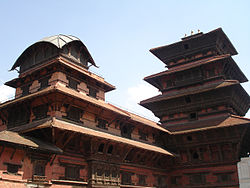Newar people
Newar (/nɪˈwɑːr/;[2] Newar: नेवार; endonym: Newa:; Newar: नेवा:, Prachalit Script: 𑐣𑐾𑐰𑐵𑑅), or Nepami,[3] are the historical inhabitants of the Nepal Mandala which consists of Nepa Valley and its surrounding areas in Nepal and the creators of its historic heritage and civilization.
 A Newar Woman | |
| Total population | |
|---|---|
| 1,321,933[1] (5% of Nepal population) | |
| Regions with significant populations | |
| Nepal | |
| Languages | |
| Newar and Nepali | |
| Religion | |
| Hinduism and Buddhism | |
| Related ethnic groups | |
| Nepal Mandala peoples; Maithils; Tibeto-Burman peoples; Other Indo-Aryan peoples |
Newar people have developed a division of labor and a sophisticated urban civilization not seen elsewhere in the Himalayan foothills. Newar people have continued their age-old traditions and practices and pride themselves as the true custodians of the religion, culture and civilization of Nepal.[3] They are the historical inhabitants of the Kathmandu Valley and its surrounding areas in Nepal and the creators of its historic heritage and civilisation.[4] Newars form a linguistic and cultural community of primarily Indo-Aryan and Tibeto-Burman ethnicities following Hinduism and Buddhism with Nepal Bhasa as their common language.[5]
The Kathmandu Valley and surrounding territories constituted the former Newar kingdom of the Nepal Mandala. Unlike other common-origin ethnic or caste groups of Nepal, the Newar people are regarded as an example of a nation community with a relic identity, derived from an ethnically-diverse, previously-existing polity. Newar civilization within it consists of various strands of ethnic, racial, caste and religious heterogeneity, as they are the descendants of the diverse group of people that have lived in Nepal Mandala since prehistoric times.
Newar People Media
The Vajji or Vṛji Mahajanapada and Malla Mahajanapada in 600 BCE; Notable Licchavi (kingdom) and Malla (Nepal) of Nepal Mandala originated from respective ones
A Newar window panel at Hanuman Dhoka, Kathmandu
Miaoying Temple, an example of Newar architecture in China
References
- ↑ Sharma, Man Mohan (1978). Census of Nepal, 2011.
- ↑ "Newar". Random House Webster's Unabridged Dictionary.
- ↑ 3.0 3.1 (Mrigendra Lal Singh. Nepami: An Idol of Yalambar. 2016)
- ↑ von Furer-Haimendorf, Christoph (1956). "Elements of Newar Social Structure". Journal of the Royal Anthropological Institute. Royal Anthropological Institute of Great Britain and Ireland. 86 (2): 15–38. doi:10.2307/2843991. JSTOR 2843991. Page 15.
- ↑ Levy, Robert I. (1991). "Nepal, the Kathmandu Valley, and Some History". Mesocosm: Hinduism and the Organization of a Traditional Newar City in Nepal. University of California Press. p. 34. Retrieved 22 May 2011.








